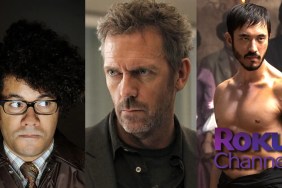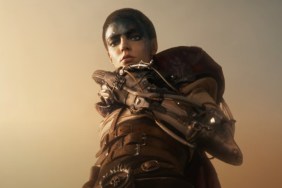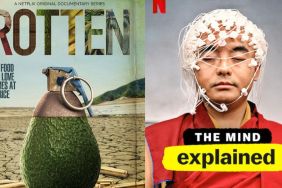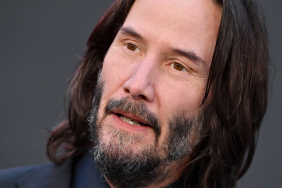15 years after Oscar-winning director James Cameron imagined the alien world of Pandora, his highly-anticipated Avatar is at last ready for audiences to see a new generation of special effects as the film offers a totally immersive cinematic experience of a new kind.
In the film, Jake Sully (Worthington) is given a mission to infiltrate the Na’vi who are getting in the way of a precious mineral that is the key to solving the Earth’s energy crisis. Unknowing to the Na’vi, Jake reports back what he has learned of their culture to help the humans take over their land, however when his relationship with Neytiri (Zoe Saldana) deepens, he must chose what side he’s really on.
ComingSoon.net was in London for the press conference with Mr. Cameron who expressed his excitement over people finally getting to see his epic adventure, and Sam Worthington, Zoe Saldana and Sigourney Weaver were also on had to talk about the film.
Q: This movie has been a long time in the making. When you finally saw it, what was you’re reaction?
Sigourney Weaver: I saw it last week and again last night for the first time with a wonderful huge audience and what really impressed me was that there are a lot of big movies that involve special effects [and] Jim Cameron is the only one I know who understands that special effects are not for effect. He uses them to enhance the emotional story and to make even sharper in this case through 3D the sensory experience of the audience experiencing the story. To supplement this incredible revolutionary breakthrough in special effects to the actual work of the actors and the relationships of the characters I think is the true accomplishment of the movie and I really felt it last night.
Zoe Saldana: I’m still trying to find words. Last night was the second time I’ve seen the movie and its finished form, but it was the first time that I saw it with an audience. It takes me a couple of days or sometimes a couple of weeks to find the kind of words or phrases that I would want to say that would best describe how it makes me feel. I’m so overwhelmed and excited and proud of the work that Jim and his team and the cast and all of us did because on every frame I saw the entire collaboration, but I also saw the vision that this gentleman had (referring to James Cameron who was sitting to her left) and it was absolutely outstanding. It only complimented the story which is supposed to be compelling.
Sam Worthington: I thought well we now know what Jim has been doing for 12 years. He’s obviously gone to f*cking Pandora hasn’t he? If he keeps going the way he’s going he might have a career.
Q: Zoe, you’re the only one in the main cast who we never see your real face in the movie. Can you talk about what it was like to take this character and do you think you’re going to be in a sci-fi groove for the rest of your career?
Saldana: I wouldn’t mind actually. Look what it did to Sigourney’s career. That’s a really good career to follow and a really good role model to have. I do wish that there were more genres in which women can have more opportunities to be presented as what we are. We’re complicated complex creatures and we’re very intricate. We also have journeys. We can be the heroes and we can save everyone and we can also be vulnerable and we can be saved as well all in one person. So that would be wonderful. I wouldn’t mind being in that category at all. The first question is I would be lying to you if I didn’t say that it didn’t cross my mind. I did entertain it for two nano seconds because it is a human condition for us to be proned to vanity especially actors because unfortunately we’re being pressured and conditioned that if it’s not our faces then you can’t go as far to meet the essence. I feel this role has been the best role that has ever crossed my path. It gave me the opportunity to find out not only myself, but to give everybody and Jim and the rest of the team, 150% of myself everyday. When I see Neytiri I see actually me in its entirety and that is a very emotional feeling for me to have.
Q: Sigourney how do you see yourself in this role?
Weaver: Grace was a wonderful combination of quality. She’s full of authority and wit, but she’s also a very conflicted person personally. It was wonderful to play someone who ends up finding her true happiness and her true home in an alien life especially after my history with aliens. It’s ironic. I think Jim is so brilliant at casting. I was so thrilled that he thought of me for Grace. I admire woman who devoted themselves to study certain things or certain causes. I felt like with what he gave me we were able to construct first of all a very believable scientist. He helped me out a lot with that, but also someone who flowers this alien world or this alien culture in a way that I found really exciting for me personally. So this was a great privilege for me to do this particularly film at this particularly point in my life.

Q: Why was there so much blue in the film and also why was there such an overly environmental message in the film?
James Cameron: I’m not sure I would agree with the fact that the message is overt and the idea that is beating you over the head throughout the film. I think it’s less of an intellectual message and more something you feel emotional. When the willow blade was destroyed after what you’ve just seen what it means to Neytiri and to her people and the way she explains it so reverently to Jake and you’ve already gone through this experience of this beautiful magical place. When the bulldozers knock the tree down I think that’s an emotional response – it’s not an intellectual response. That’s what I wanted. I wanted people to feel the environmental message not think about it – not have it sort of droning on as information. It’s kind of the exact opposite of an inconvenient truth with the bar graphs and all of that. It’s important information to have. We get that information from other sources in something that’s an adventure film, an action film I think it’s more important to get these concepts viscerally if you will. Science fiction can operate on many different levels. It can operate as a cinema just purely of the visual – a cinema purely of imagination. Historically the science fiction films I grew on had a message. Usually it was a dystopian message – usually it was in the form of some kind of warning. As much as I love “Star Wars” and I loved all of the films that came after that celebrated action and imagery, there was a moment in history when science fiction became more of an escapist fantasy and less warning and less of a kind of intellectual meaning. I think “Avatar” was an attempt to merge science fiction back to its roots of having a warning. You’re first question was about blue. I love blue.
Producer Jon Landau chimes in and wants Sam Worthington to tell a story about something that happened during rehearsals in Hawaii so the star of the film begins to talk about the funny incident and had the entire room of reporters laughing.
Worthington: We went to Hawaii to look at reference and stuff. We had to wear tiles and ears and a flimsy g-string and run around basically half naked pretending to be our characters which was all well and good except for when some guy came up to me and said, “So what are you doing here?” I said, “We’re filming a movie.” He looked over and there was Jim Cameron with handycam. He said, “He’s the director?” I said, “Yeah that’s James Cameron.” He said, “F*ck, he’s gone a long way down since ‘Titanic.'”
Q: I think one of the most important things in the film is about seeing and the difference between truly seeing and just seeing. Can you talk about that aspect of the film?
Cameron: Ah, “The Abyss.” That is a great question. That’s really the heart of the film, isn’t it? Zoe’s character Neytiri says, no one can teach you to see, it has to come from the inside. We’re all born with a mind and as kids we’re very curious, and I think that as we get older we need to stay curious and informed. I think most importantly we need to have an openness about other cultures and other points of view. I’ve been kind of struck because “Avatar” is kind of about living vicariously and so on, and obviously as a society we’re spending more and more time plugged into the internet with social networking and so on, and you know, I always thought the internet had this amazing potential to let us have friends in other cultures and other countries and to really kind of net the world together. But really what I’m seeing is the emerging pattern is that people use the internet to find people like them and to essentially close into a bubble of reality, a self-defining bubble, where you find people like you and you all agree on everything and you live in these kind of little bubbles of reality. And so I think we need to just break those self-defining, self-referential bubbles and reach out and see people from other perspectives. I think films are good at doing that. I’m blessed as a filmmaker to be able to travel the world and to meet people in all different cultures and language groups and so on. So I’ve tried to live my life that way, and I suppose the film is asking us to do that as well. I don’t say I’m perfect at it. There are some culture things that I do have a big problem with, in terms of the treatment of women and things like that, but we have to see the world through other people’s eyes. Just like in any negotiation, you have to see the moment of the negotiation through the eyes of the person on the other side, or you’re never going to get anywhere, you know, and then we’ll wind up in these pointless and sort of brutal wars.
Q: My question is for Sam. Just interested in any nerves you were feeling given the size of this project.
Worthington: Well, I think all of us tried to come across as cool, calm, and collected, but I’m sure we [were] sweating some kind of bullets. But I think, there’s nothing we can do about it now, you know, you can’t change the movie, it’s locked off. So I stand by the product a hundred percent, like I stand by this man. I think we give it to an audience and hopefully it blossoms. And then, to go with what Jim’s been saying about seeing in other people’s eyes, the pressure’s maybe on that. Suddenly we, this movie, can help make a difference maybe. But I don’t feel any pressure because I think the movie’s cool.

Q: James, how did you create the [Na’vi] language. And how was it for the actors to learn this to say in the movie?
Cameron: I’ll let the actors answer the second part of that. But the way that the language was created, it started off innocently enough as I was writing the script. I came up with some place names and some character names and so on. You know, I was just sort of free-associating. And I had been to New Zealand a few years ago and really liked the sound of the Maori language and some of the Polynesian form, so I put that in. And when I found Dr. Paul Fromer, who is the head of the linguistic department at the University of Southern – USC in Los Angeles. He kind of started to riff on that, and he brought in different sounds from different languages. Some African languages, European languages, even some Native American sounds. And he ran the whole sound–what did he call it?–he called it a sound palette I think or something like that. Sound system. He ran the sound system past me. He would literally make little MP3’s of like sounds like [makes click noises]. You know, things like that, I’d be getting all these weird sounds, he’d give me some example words and so on, and I’d say okay, that sounds good. He’d start to make sentences. And at first some of it was a little too guttural or sharp. I said no, the Na’vi language needs to be very mellifluous, almost melodic. So he started to change that. He wanted to find things that the actors could still pronounce but which would sound a little bit alien to our ear, at least in terms of let’s say European-based culture. So he went to Indonesian sounds and like some bushman clicks and things like that. Well, it turns out that in practice some of the sounds were just too hard for the actors so then he had to clean it up so it was actually pronounceable. And then in the casting process, we actually asked candidates from the various roles to actually read from a list of sounds, and Margery Simpkin, who was the casting director, she got very good at making the sounds and she’d sort of coach them through it and all that sort of thing. But I want to hand it over to you, Zoe. Zoe was the first one to really sort of have to learn the language, and then as she kind of owned the language, then everybody else had to sort of match her pronunciation of it, and her accent as well.
Saldana: It was tons of fun. I mean, even the sounds you would go [makes sound], like those things would take a lot of getting used to and my mom would look at me like I was crazy. Because we’d be at a dinner table [makes sound] I would have to be making that sound, but I just, I think it was the curiosity and the excitement of doing something that was so new, so unique, and so creative, you know. Everybody that tweaked and Jim working along with Paul, they were so, I don’t know, cool. They would make these sounds and then if we kept trying, we couldn’t achieve them, they would find a way to smoothly just soften them and it would sound also attractive. The vowels to me were very identify – they would identify the vowels in the language that Jim and Paul wrote because I speak Spanish and these vowels are very similar to, you know, to the tongue. To Latin. But the hardest thing for me was actually speaking English with an Na’vi accent. Harder than anything. Learning the language was, made it look like a piece of cake. Martial arts, the kick, the archery, the riding a horse without a saddle, was a piece of cake when it came to [with accent “you should not be here”]. I’m like, God, it sounds like Queens. It would always sound like Queens.
Q: What about Sam and Sigourney?
Worthington: I have enough trouble with English. Plus having to be American, and then, let alone Na’vi. So I kind of took the approach of, which is, I think it’s a good approach, was Jake learns Na’vi, so, Sam didn’t go to Na’vi school. I learned it as the movie went along. And I think then you’re not having to deconstruct anything that you… and I think it helps more with the acting. He’s learning as he goes and I was learning as I went. I think it just made my job a bit easier. But yeah, it’s definitely hard. I couldn’t roll my I’s and things like that so Paul would definitely have to change certain things.
Saldana: Well, you still can’t.
Worthington: I still can’t.
Cameron: I just want to share one thing about Sam. When Neytiri pops Jake on the head that wasn’t rehearsed. She was just so frustrated listening Sam trying to pronounce Na’vi she just hit him on the head. It’s actually one of my favorite moments in the film.
Weaver: You know, for Grace, what I loved about the Na’vi, just in terms of the civilization. The language was just yet another aspect that Jim came up with to separate us from Na’vi culture. And I loved in the first scene how you know, Joel David Moore’s character comes on with this very earnest Na’vi and Grace is like yeah, you know, it’s a little formal. The fact that there would be a colloquial Na’vi and a formal Na’vi , just alluded to how thorough this world is that Jim created with so many different experts from so many fields.

Q: Regarding the 3D, there are moments in the film when the effects are very physical, inwards, outwards. There are moments that are not very physical. Is that something that has to do with our eyes or is that in the movie?
Cameron: Well, I think that up until now, every filmmaker who has made a 3D film has really felt it incumbent upon themselves to constantly remind you that you’re watching a 3D movie by having things that come out into the viewer’s space, and feel like they’re quite present. Actually kind of invading your personal space. It’s usually things that are floating or poking out of the screen and so on. So I sort of took the approach that if I’m constantly reminding you that you’re watching a 3D movie, then you’re constantly sitting there reminded that you’re in a movie theater. I didn’t want you to spend the whole two hours and forty minutes in a movie theater, I wanted you to go to Pandora. So we approached the 3D as if it were a window, or I like to think of it as a portal, into a reality. And that window sits sort of comfortably at some distance from your, from you, and through that you see the characters and the scenes and the world and so on. And so we didn’t look for opportunities to constantly exercise the, our 3D muscle, in front of you. And part of it was because it was going to be a two and a half hour movie at the time that we embarked on it, and so we didn’t want to wear out our welcome, we didn’t want it to feel like a gimmick. We wanted it to feel like a natural part of the cinematic art. In the same way that digital sound improves the way you hear the film and the sort of spatial reality of the film, when we first got surround sound and then 5.1 sound, it just kind of created this enhanced form of cinema. I think 3D is enhanced cinema, but I think it’s still fundamentally cinema. I don’t think you start rewriting the fundamental rules of how you make a movie because it’s a 3D movie. So this is hopefully what, maybe one thing that “Avatar” can achieve, is an example of a mature use of stereoscopic 3D. And let it move out of its adolescence into a mature acceptance as just part of the cinematic art, by serious filmmakers, and I don’t think, I don’t have a problem with that idea. I’m going to make all my movies in 3D, no matter what their subject. To just to sort of continue to make that point. And we’ll see if other filmmakers rise to that challenge.
Q: The film was great in 3D, but how much of the experience do you lose watching it in 2D?
Cameron: That’s always been an issue with 3D. The question is how much of the experience do you lose when you listen to a six track or a 5.1 surround stereo movie when you watch it on a two track? You know, there’s a diminishment. It’s measurable. Does it really hurt a well-made film? Does it in any way diminish a good performance or good lighting or good visual effects? I don’t think so. So I think that we need to keep 3D in balance. Yes it’s an improvement to the viewing, but I think that ninety-eight percent of my focus as a filmmaker is on, you know, the writing and performance, the design, shot composition, lighting, sound mixing, all of those things. All of which are equal across the two platforms. And you know, we’re very proud of the 2D version of the film that we put out. The prints are all made from original DNs, the digital negatives, so they’re not made from a dupe master, so they’re absolutely grain free. They’re better than any of the prints that we put out on “Titanic.” The colors are beautiful, it’s a bright, clear, colorful presentation of the movie. And so I think you can’t go wrong in either medium. But I think it really comes down to consumer choice. You know, people want to pay the extra money for a bigger plasma screen, they can watch their movies at home, their DVDs, on a bigger screen. If they want to spend less money, they’ll have a smaller screen. You know, if you want to go to a 3D movie, you’ve got to pay the up charge of an extra couple of two or three dollars, you know, to get the glasses and so on. So these are consumer choices now at this point. So I think of the 3D as the premium experience of the film and the 2D as the excellent base level presentation of the film.
Avatar opens worldwide this week!









